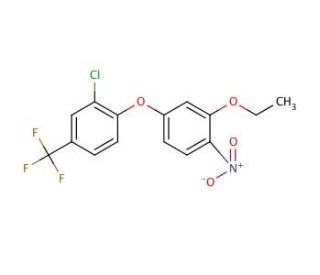

Oxyfluorfen (CAS 42874-03-3)
QUICK LINKS
Oxyfluorfen, a diphenyl-ether herbicide, finds common usage in vineyards as a means of managing weed control. It effectively disrupts the biosynthesis of chlorophyll in plants by inhibiting the enzyme protoporphyrinogen oxidase. This herbicidal compound presents itself as an orange crystalline solid, possessing a non-corrosive nature. Its primary function lies in its role as an herbicide. Oxyfluorfen falls under the category of aromatic ethers, serving both as a herbicide and an inhibitor of the EC 1.3.3.4 enzyme, protoporphyrinogen oxidase. Herbicides of the diphenyl-ether type display extraordinary potency in inhibiting protoporphyrinogen oxidase, an enzyme essential to the pathways of heme and chlorophyll biosynthesis. The phytotoxic activity of diphenyl-ether herbicides is exerted by impeding chlorophyll formation within plants. This outcome arises from the inhibition of protoporphyrinogen oxidase, the final step in the shared pathway for the biosynthesis of chlorophyll and heme.
Oxyfluorfen (CAS 42874-03-3) References
- Photolysis of oxyfluorfen in aqueous methanol. | Chakraborty, SK., et al. 2013. J Environ Sci Health B. 48: 919-26. PMID: 23998303
- Field dissipation of oxyfluorfen in onion and its dynamics in soil under Indian tropical conditions. | Janaki, P., et al. 2013. J Environ Sci Health B. 48: 941-7. PMID: 23998306
- Persistence of oxyfluorfen in soil, runoff water, sediment and plants of a sunflower cultivation. | Mantzos, N., et al. 2014. Sci Total Environ. 472: 767-77. PMID: 24333999
- Characterization of a novel oxyfluorfen-degrading bacterial strain Chryseobacterium aquifrigidense and its biochemical degradation pathway. | Zhao, H., et al. 2016. Appl Microbiol Biotechnol. 100: 6837-6845. PMID: 27079576
- Simultaneous efficient removal of oxyfluorfen with electricity generation in a microbial fuel cell and its microbial community analysis. | Zhang, Q., et al. 2018. Bioresour Technol. 250: 658-665. PMID: 29220810
- In-vitro assessment of the binding mechanism of oxyfluorfen (herbicide) with garlic phytocystatin: multi-spectroscopic and isothermal titration calorimetric study. | Siddiqui, MF. and Bano, B. 2019. J Biomol Struct Dyn. 37: 4120-4131. PMID: 30394179
- Cytotoxic and genotoxic effect of oxyfluorfen on hemocytes of Biomphalaria glabrata. | de Vasconcelos Lima, M., et al. 2019. Environ Sci Pollut Res Int. 26: 3350-3356. PMID: 30506409
- Sorption, degradation and bioavailability of oxyfluorfen in biochar-amended soils. | Wu, C., et al. 2019. Sci Total Environ. 658: 87-94. PMID: 30572218
- Removal of oxyfluorfen from polluted effluents by combined bio-electro processes. | Carboneras, MB., et al. 2020. Chemosphere. 240: 124912. PMID: 31574437
- Electrochemically assisted dewatering for the removal of oxyfluorfen from a coagulation/flocculation sludge. | Acosta-Santoyo, G., et al. 2020. J Environ Manage. 258: 110015. PMID: 31929057
- Acute liver injury associated with Oxyfluorfen toxicity. | Pirasath, S., et al. 2021. SAGE Open Med Case Rep. 9: 2050313X211000454. PMID: 33854778
- Oxyfluorfen induces hepatotoxicity through lipo-sugar accumulation and inflammation in zebrafish (Danio rerio). | Li, Z., et al. 2021. Ecotoxicol Environ Saf. 230: 113140. PMID: 34979306
- Development of immunoassays for detecting oxyfluorfen residue in agricultural and environmental samples. | Sheng, E., et al. 2018. RSC Adv. 8: 5020-5025. PMID: 35539517
- Assessment of oxyfluorfen-tolerant rice systems and implications for rice-weed management in California. | Galvin, LB., et al. 2022. Pest Manag Sci. 78: 4905-4912. PMID: 36069293
- Oxyfluorfen induces cell cycle arrest by regulating MAPK, PI3K and autophagy in ruminant immortalized mammary epithelial cells. | Jang, H., et al. 2023. Pestic Biochem Physiol. 193: 105461. PMID: 37248026
Ordering Information
| Product Name | Catalog # | UNIT | Price | Qty | FAVORITES | |
Oxyfluorfen, 100 mg | sc-250623 | 100 mg | $112.00 |
